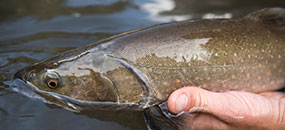New TU Report Demonstrates Vital Link between Oregon's Roadless Lands and Native Fish, Wildlife
Bulk of state’s remaining healthy salmon, steelhead & trout depend on headwaters and tributaries found within federal roadless lands, which also support its longstanding fishing, hunting and outdoor recreation tradition
Contact:
Alan Moore
Western Communications Director
Trout Unlimited
503.827.5700
6/22/2004 -- Portland, Ore. -- A report being released Tuesday by Trout Unlimited (TU) shows clearly the correlation between Oregon’s remaining undeveloped federal roadless lands and its best remaining native coldwater fish populations and consequently the state’s best remaining opportunities for fishing, hunting, wildlife-watching and other outdoor recreation pursuits.
“There is a strong link between Oregon’s healthiest remaining trout, salmon and steelhead populations and the availability of intact, unroaded federal lands within their home watersheds,” said TU Wildlands Fisheries Coordinator Sam Mace. “Roadless lands provide high quality spawning and rearing habitat as well as cold clean water for downstream fisheries. Clearly anyone interested in seeing these fish populations continue to thrive has to recognize the importance of protecting the areas that sustain them.”
As with most western states, Oregon’s wild native fish populations have suffered from decades of habitat loss and encroachment, dams, water diversions, logging, road-building and myriad other insults to their long-term sustainability. Despite that, however, Oregon still boasts a wide array of native fish populations, and many are still holding on or even thriving thanks to healthy habitat in roadless areas. The report notes that:
• 83 percent of bull trout spawning and rearing habitat in Oregon is found in areas with significant roadless lands.
• Several of the healthiest salmon and steelhead fisheries found in the lower 48 states are thriving in southern Oregon’s Siskiyou region, supported by a complement of free-flowing rivers and large complexes of roadless public lands.
• Oregon’s remaining westslope cutthroat trout populations are found in roadless areas of the John Day River Basin.
• While Oregon’s Lahontan cutthroat populations have been reduced from eight to just two, both are found in watersheds that remain predominantly roadless.
The TU report highlights several critical areas that feature large reserves of roadless lands including Mt. Hood/Clackamas watershed, Steens Mountain, Hells Canyon/Eagle Cap Mountains, the Siskiyous and the John Day River Basin. Trout Unlimited is encouraging anglers, hunters and others vested in preserving Oregon’s outdoor recreation heritage to make their voices heard in protecting these and other remaining roadless lands.
Tom Wolf, a sixth-generation Oregonian and president of TU’s Oregon Council, has long recognized the value of roadless areas in his years of pursuing trout, salmon and steelhead across the state.
“To hike down a steep canyon into one of these roadless areas and cast a fly into its waters is to feel transported back 200 years to the time of Lewis and Clark,” Wolf said. “They are rare and precious gems that deserve to be protected for all future generations.”
As demonstrated in TU’s report, there is no shortage of current and future generations both of Oregonians and visitors to the state who regularly take time to enjoy its outdoor opportunities. The report notes that:
• 687,000 people fished in Oregon in 2001, 249,000 people hunted and another 2.1 million participated in wildlife watching.
• Anglers spend about $602 million in Oregon annually, hunters about $365 million and wildlife watchers another $769 million.
• Among Oregon residents, there are approximately 513,000 anglers and 234,000 hunters.
Roadless lands comprise about 20 percent of Oregon’s land base, but currently just over 2.1 million of the over 10 million acres of roadless public land is protected by congressionally mandated wilderness designation.
“Oregonians owe it to themselves, future generations and their own fish and wildlife heritage to see that more of these irreplaceable public lands are protected forever,” Wolf added.
View the report, “Where the Wild Lands Are: Oregon” at www.tu.org or email Alan Moore at amoore@tu.org for a hard copy.
Mission: Trout Unlimited is North America’s leading coldwater fisheries conservation organization, dedicated to the conservation, protection and restoration of trout and salmon fisheries and their watersheds. The organization has more than 130,000 members in 450 chapters in North America.
Date: 6/22/2004



